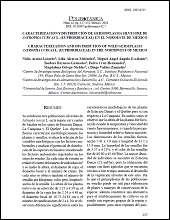Mostrar el registro sencillo del ítem
CARACTERIZACIÓN Y DISTRIBUCIÓN DE GERMOPLASMA SILVESTRE DE Jatropha curcas L. (EUPHORBIACEAE) EN EL NOROESTE DE MÉXICO
CHARACTERIZATION AND DISTRIBUTION OF WILD GERMPLASM Jatropha curcas L. (EUPHORBIACEAE) IN THE NORTHWEST OF MEXICO
| dc.creator | NIDIA ARAIZA LIZARDE | |
| dc.creator | LILIA ALCARAZ MELENDEZ | |
| dc.creator | MIGUEL ANGEL ANGULO ESCALANTE | |
| dc.creator | TEODORO REYNOSO GRANADOS | |
| dc.creator | PEDRO CRUZ HERNANDEZ | |
| dc.creator | MARIA MAGDALENA ORTEGA NIEBLAS | |
| dc.date | 2016 | |
| dc.identifier | http://cibnor.repositorioinstitucional.mx/jspui/handle/1001/1186 | |
| dc.identifier.uri | http://dspace.cibnor.mx:8080/handle/123456789/1961 | |
| dc.description | "Se estudiaron tres poblaciones silvestres de Jatropha curcas L. en la región sur y centro de Sinaloa en los sitios de Estación Dimas, La Campana y El Quelite. Los objetivos fueron caracterizar morfológicamente las plantas y semillas, evaluar la relación de las variables morfológicas con los factores ambientales y analizar el potencial de distribución de las especies en Sinaloa considerando los factores ambientales registrados en los sitios de estudio. En cada sitio de estudio se realizó el conteo del número de individuos/m2 y se midió la altura, el diámetro de copa, el diámetro basal y el número de ramas. De cada sitio se obtuvo también el número de semillas por kilogramo, color, peso, longitud y ancho de la semilla. La altura de las plantas estuvo en un intervalo de 2.25 a 4.59 m, el diámetro de la copa fue de 2.24 a 4.48 m, el diámetro basal de 18.75-24.81 cm y el número de ramificaciones de 2 a 4. No se observaron diferencias significativas entre las características morfológicas de las plantas de Estación Dimas y el Quelite pero sí con respecto a La Campana. En ambos sitios se observó que la altura de las plantas fue favorecida cuando la temperatura y velocidad del viento fueron menores, y cuando la precipitación y humedad relativa fueron mayores. Las dimensiones de las semillas fueron, ancho 7.41 a 7.9 mm y longitud de 15.1 a 15.9 mm. La humedad de las semillas fue de 3.57 a 4.21%, y el color de las semillas fue de 60.80 a 65.64°Hue. La mayor densidad de individuos se encontró en Estación Dimas (21 ind/ha), pero la utilización del campo con fines agrícolas que se encuentra cercana a este ecotipo amenaza al desarrollo de la vegetación silvestre de este sitio. Por lo que el germoplasma de las poblaciones en estudio puede ser útil para elaboración de planes y manejos de conservación de la especie, además constituye una alternativa para el establecimiento de cultivos en el estado con especies propias de la región y, posiblemente, para otras regiones del país. Por otro lado, se observó que la especie tiene un alto potencial de distribución en el estado de Sinaloa principalmente en los municipios de Sinaloa de Leyva, Guasave, Guamúchil, Culiacán, Elota, San Ignacio, Mazatlán, Villa Unión, Concordia y Escuinapa." | |
| dc.description | "Three wild populations of Jatropha curcas in the central and southern parts of Sinaloa were studied; Estación Dimas, La Campana, and El Quelite. The objectives were to characterize plants and seeds morphologically to assess the relationship between morphologica traits and environmental factors and the potential distribution of the species considering environmental factors from the study sites. All individuals/m2 and number of branches were counted, and height, diameter of cup, and basal diameter were measured. The number of seeds per kilogram was obtained, as well as color, weight, and seed length and width. Plant height ranged from 2.25 to 4.59 m; the crown diameter from 2.24 to 4.48 m; basal diameter from 18.75 to 24.81 cm; and branch number 2 to 4. No significant differences were found in morphological characteristics between plants from Estación Dimas and El Quelite but those from La Campana were significantly smaller. Plant height was favored in sites with lower temperature, altitude, and wind speed, and with higher precipitation and relative humidity. Seed length ranged from 7.41 to 7.9 mm and seed width from 15.1 to 15.9 mm. Seed moisture ranged from 3.57 to 4.21%. The seed color ranged from 60.80 to 65.54° Hue. The highest tree density was found in Estación Dimas (21 ind/ha), but agricultural practices threatens the vegetation in this site. The species has a high potential for distribution in the southern and central parts of the state. Germplasm from the studied populations may be useful for plans and management for species conservation; they also constitute an alternative to the establishment of crops in the state of Sinaloa with typical species of the region and possibly other regions of the country. Moreover, it was observed that the species has a high potential for distribution in the state mainly in the municipalities of Sinaloa de Leyva, Guasave, Guamuchil, Culiacan, Elota, San Ignacio, Mazatlan, Villa Union, Concordia, and Escuinapa." | |
| dc.format | application/pdf | |
| dc.language | spa | |
| dc.publisher | Instituto Politécnico Nacional, Escuela Nacional de Ciencias Biológicas | |
| dc.relation | info:eu-repo/semantics/reference/ISSN/ISSN: 2395-9525 | |
| dc.relation | info:eu-repo/semantics/reference/DOI/DOI: 10.18387/polibotanica.42.7 | |
| dc.relation | info:eu-repo/semantics/reference/URL/URL:http://www.encb.ipn.mx/herbario/polibotanica/index.html | |
| dc.rights | info:eu-repo/semantics/openAccess | |
| dc.rights | http://creativecommons.org/licenses/by-nc-nd/4.0 | |
| dc.source | Polibotánica | |
| dc.subject | info:eu-repo/classification/AUTOR/densidad, distribución, semilla | |
| dc.subject | info:eu-repo/classification/AUTOR/density, distribution, seed | |
| dc.subject | info:eu-repo/classification/cti/2 | |
| dc.subject | info:eu-repo/classification/cti/24 | |
| dc.subject | info:eu-repo/classification/cti/2417 | |
| dc.subject | info:eu-repo/classification/cti/310311 | |
| dc.subject | info:eu-repo/classification/cti/310311 | |
| dc.title | CARACTERIZACIÓN Y DISTRIBUCIÓN DE GERMOPLASMA SILVESTRE DE Jatropha curcas L. (EUPHORBIACEAE) EN EL NOROESTE DE MÉXICO | |
| dc.title | CHARACTERIZATION AND DISTRIBUTION OF WILD GERMPLASM Jatropha curcas L. (EUPHORBIACEAE) IN THE NORTHWEST OF MEXICO | |
| dc.type | info:eu-repo/semantics/article | |
| dc.type | info:eu-repo/semantics/publishedVersion |


